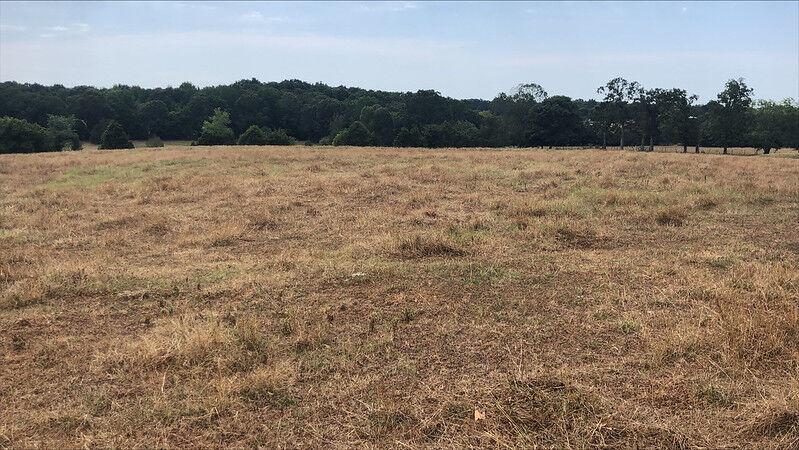As triple-digit temperatures and weeks without rain suck the life out of pastures and hay meadows, Arkansas’ cattle producers are having to sell part or all of their herds.
Kevin Lawson, who directs extension activities in the 25-county Ozark District, an area heavy in cattle, doesn’t mince words about what he has seen.
“We’re on the edge of a disaster,” he said this week.
The U.S. has seen its share of drought this year. During the spring, Arizona, New Mexico, as well as west Texas and western Oklahoma were hard hit. As summer brings the heat, the Mid-South is drying out too.
Some spots in Arkansas haven’t seen anything more than a sprinkle since the beginning of June. The lack of rain is showing up in both the National Agricultural Statistics Service’s weekly crop report—which shows 43% of pastures in poor or very poor condition—and the U.S. Drought Monitor, whose July 11 report shows all of Arkansas being in drought. The most intense drought areas are in the north and southwestern parts of the state.
“We’re holding steady right now,” said Michael Lee, who runs Flying C Ranch, a cow-calf operation in Faulkner County. “The grass is struggling. If it doesn’t rain pretty significantly in the next week or two, there will probably be a lot of cows that will have to be sold here on the farm.”
One for the books
Herb Ginn, Crawford County extension staff chair for the University of Arkansas System Division of Agriculture, said that while some hay growers are working on their second cutting, “it leaves a lot to be desired.
“This is one for the books, though we hadn’t yet broken the high temperature record in Fort Smith,” Ginn said.
Zach Gardner, Faulkner County extension agent, said a hayfield being used for an integrated pest management demonstration last year produced 242 round bales in its first cutting. This year, that number is down to 151 bales.
“People are trying to find hay and no one is wanting to sell hay. Even those who might have carryover from last year, and those who have irrigated hay, are still not selling it,” Gardner said. “There is no hay to buy.”
Gardner said no one in his county has resorted to feeding hay yet. “They’re aggressively rotating cattle to different fields, but it’s not going to be much longer before we don’t get any rain.”
Desperate times
“Desperate times call for desperate measures and if things continue as they are, some producers may be forced to sell their cattle. They can’t feed them,” Ginn said.
“In Faulkner County, there’s a lot of cattle going to the sale barn. People are reducing herd sizes,” Gardner said.
James Mitchell, extension livestock economist for the Division of Agriculture, pointed to the national figures on cattle slaughter.
“From January to June, total beef cow slaughter is at its highest level since 1996,” he said. “If you look at the number of head slaughtered as a percentage of the January 1 inventory, that’s 5.3% of available cows in the U.S. That would be confirmation that we’re seeing people sell off their herd, are culling, or are digging deeper into their herds to cull more cattle.
“Drought is pressing some hard decisions for people,” Mitchell said.
The higher numbers of cattle being processed doesn’t necessarily translate into lower prices.
“If we’re slaughtering this many cows in a year, that would suggest a large supply of beef cows and that those prices should be lower,” he said. “If you look at auction prices for slaughter cows, we’ve had a very strong slaughter market. Prices are 5% to 8% above a year ago at this time.”
Mitchell said the situation is being driven by strong consumer demand.
“One of the biggest stories is that through inflation, customers aren’t substituting away from beef,” he said. “They’re substituting from a higher-end steak to something more affordable—ground beef.”
As for retail prices, there won’t be an immediate effect.
“If you think about that newborn calf, it takes two years to become a steak on your plate,” Mitchell said. “You’ll see higher prices in a year or two with fewer cattle going to slaughter. There’s a bit of a lag between drought and its effect on prices.”
“The demand is holding steady and I’m optimistic about that,” Lee said. “The demand is still there and the supply for now is still there. The drought will play a big role in supply and demand.”
Lee said it was important for consumers to educate themselves about what goes on in the beef industry.
“At the end of the day, it might affect them at the store,” he said.
In addition to seeking advice from their county extension office, Mitchell said producers should visit the Farm Service Agency for information about the Livestock Forage Disaster Program for assistance.
Managing forage in drought
“Temperatures over 100 degrees limit growth of all forages,” said John Jennings, professor and extension forage specialist for the Division of Agriculture. “Some areas have received scattered showers, but pasture recovery will require more than a few rain showers due to the dry soil profile and continued high temperatures.
“For much of the state, pastures are being grazed short and producers are about to start feeding hay,” he said. “In those cases, management strategies must focus on pasture recovery after drought.”




